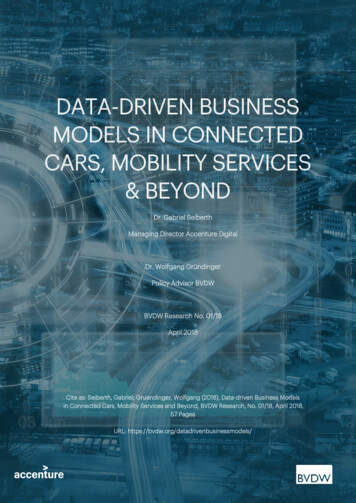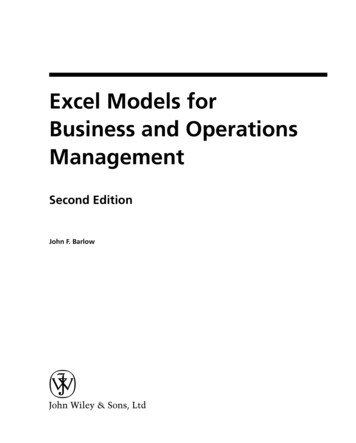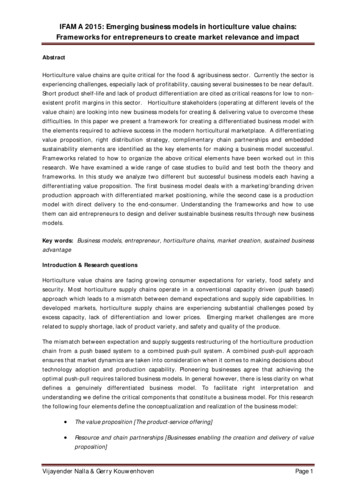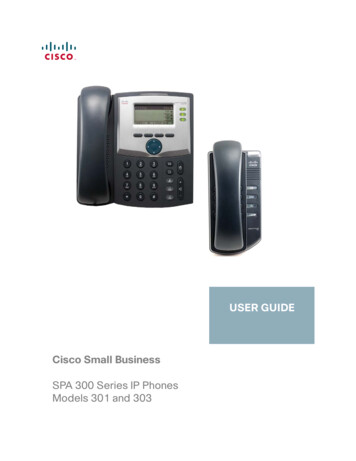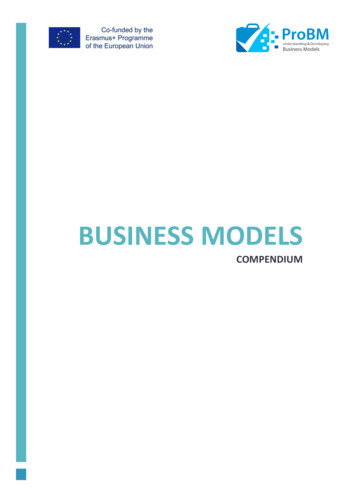
Transcription
BUSINESS MODELSCOMPENDIUM
This publication was supported in part by the European Fund through ERASMUS Adult Educationproject No 2016-1-PL01-KA204-026123 entitled: “Understanding and Developing Business Models(ProBM)”Business Models – compendiumEditors: Ludmiła Walaszczyk, Elmo de Angelis, Kylene de Angelis, Mojca Vucovič, Gabriela Vlckova,Evanthia BatzogianniAuthors: Ludmiła Walaszczyk, Elmo de Angelis, Kylene de Angelis, Mojca Vucovič, Gabriela Vlckova,Evanthia Batzogianni, Stella IoannouReviewers: Angelo Caruso (University of Urbino – Italy), Jasna Colnerič (REALKA, izobraževanje,drugo usposabljanje in svetovanje, Jasna Colnerič, s.p. – Slovenia), Vasilis Avramoudis (OpenMellon Company – Greece), Václav Matějka (Pivo Jinak – The Czech Republic), Józef Bućko (InstytutTechnologii Eksploatacji – PIB, Poland)The content of the publication does not necessarily reflect the position of European Community orNational Agency, nor does it involve any responsibility on their part.Copyright by: Institute for Sustainable Technologies – National Research Institute – Poland, Training2000 – Italy, Ljudska Univerza, Zavod za Izobrazevanje in Kulturo in Rogaska Slatina – Slovenia,Institute of Entrepreneurship Development – Greece, GLAFKA – The Czech RepublicISBN: 978-83-7789-513-9Publishing House of the Institute for Sustainable Technologies – National Research Institute6/10 K. Pułaskiego Street, 26-600 Radom, tel. 048 48 364-42-41, fax 048 48 364-47-65e-mail: instytut@itee.radom.plhttp://www.itee.radom.pl1
ContentsIntroduction . 4CHAPTER 1. BUSINESS MODELS – THEORETICAL BACKGROUND . 71.1.Reasons, why a business model is important . 71.2.Classifications of business models . 71.3.Key elements of business models . 101.3.1.Key partnerships . 111.3.2.Key activities . 121.3.3.Key Resources . 121.3.4.Cost structure. 131.3.5.Relation with clients (Customer Relationships) . 141.3.6.Communication channels (Customer Channels) . 151.3.7.Revenue streams . 171.3.8.Value propositions . 18CHAPTER 2. CASE STUDIES ANALYSIS – EXECUTIVE SUMMARIES. 20Introduction . 202.1.Poland . 202.2.Italy. 212.3.Slovenia . 212.4.Greece . 222.5.The Czech Republic . 22CHAPTER 3. QUESTIONNAIRE RESULTS ANALYSIS – EXECUTIVE SUMMARIES . 24Introduction . 243.1.Poland . 263.2.Italy. 263.3.Slovenia . 273.4.Greece . 283.5.The Czech Republic . 29BANK OF ACTIVITIES – EXAMPLES . 30Activity 1: Your ideal business model (choose the sector). 30Activity 2: Your ideal business model for a lavender products shop . 31Activity 3: Develop the business idea . 322
Activity 4: Carrying out a market analysis . 34Activity 5: Business Plan . 35Activity 6: Business Model . 36WORD BANK . 37RECOMMENDATIONS . 39ANNEX 1 – INTERNATIONAL REPORT – NATIONAL SURVEY. 41REFERENCES . 743
IntroductionEuropean and worldwide markets have been suffering in the recent years from significantand sudden changes due to different processes, for example, globalisation, European integration, ICTdevelopment, and global economic crisis. All these elements impose companies to change theirbusiness strategies and business models in order to fight against the challenges imposed by theglobal competition. This change becomes even more necessary when small and medium enterprisesare mentioned, because they are more exposed to the loss of competitiveness coming from marketchanges. The interactions between companies and other market players are considered as keyfactors in developing successful businesses (Mele, Russo-Spena & Colurcio, 2010) and in order tohighlight these elements, a clear model is crucial to define a correct strategy.From the current landscape, the need to change the way of running a business in a radicalway is emerging, starting from re-designing the business model.Entrepreneurs must take decisions based on their cognitive framework. It plays a crucial rolein interpreting ambiguous signals and thus in strategic choices (Walsh, 1995). Therefore, a keyelement is to re-design this cognitive framework in order to make sense of a complex and changingenvironment. A correct framework will lead to a successful business; however, unsuitable mentalmodels will result in inadequate responses to the environment.Unfortunately, updating cognitive frames is not easy. Inertial forces delay the updating process and very oftenonly extremely strong signals are able to force change. There is, therefore, a clear need for tools andmethodologies capable of facilitating changes to cognitive frames to help decision makers update theirinterpretation of a firm’s situation before it deteriorates (Vedovato, 2016).A business model can be used as a tool to foster company changes and to adapt the business to thecurrent situation.The term "business model" is a relatively young phenomenon. Although it appeared for thefirst time in the academic article in 1957 (Bellman, Clark et al. 1957) and in the title and abstract ofa paper “Educators, Electrons, and Business Models: A Problem in Synthesis” in 1960 (Jones, 1960), itrose to prominence only towards the end of the 1990s. Various researchers have made studies onbusiness models, mainly in the design and management field (Osterwalder et al., 2014; Battistella etal., 2012). Over the years, the concept of a business model has gained increasing attention inacademic and management environments (Zott, Amit, Massa, 2010).The concept of business model has been used by strategy scholars to refer to “the logic of thefirm, the way it operates, and how it creates value for its stakeholders” (Casadesus-Masanell& Ricart, 2009).4
At the San Jose State University, a business model is described as “a simple description or anaccount or a conceptual plan of how a business will make a profit.” Meanwhile, the Epia Consultingdefines a business model as “a model, which helps organisations to realise the economic value oftheir product, services, business, and /or technology.”A very clear and detailed definition of a business model is given by Osterwalder, Pigneur andTucci (2005):A business model is a conceptual tool that contains a set of elements and theirrelationships and allows expressing the business logic of a specific firm. It is a descriptionof the value a company offers to one or several segments of customers and of thearchitecture of the firm and its network of partners for creating, marketing, and deliveringthis value and relationship capital, to generate profitable and sustainable revenuestreams (Osterwalder, Pigneur & Tucci, 2005).In the last few years, the attention for innovative business models has also been raised in differentindustrial contexts. A clear evidence of the importance of innovative business models washighlighted mainly in the web companies and e-businesses (Timmers, 1998). The development ofstart-ups (characterised by high level of innovation and education) fostered the propagation of newbusiness models and strategies. These are mainly applied in the digital economy, but the businessmodels’ innovation is also considered more and more important in other markets, e.g., productionindustries or commodities.As Osterwalder said in his work on Business Model Generation, “business model innovation is about creatingvalue for companies, customers, and societies. It is about replacing outdated models”(Pisano, Cautela & Pironti, 2014).A business model can be analysed with the use of different methodologies and tools. As an example,visualisation methods are usually used to have tangible elements to reflect on. This approachprovides ways of examining and improving managerial judgement by transforming raw data intoaccessible forms of knowledge representation (Yee, Walker & Menzfield, 2012). Visualisation canenable the reframing of current views, foster changes in perspectives, and facilitate the systematicand global comparison of many options (Eppler & Platts, 2009). Visualisation tools have already beenused in the past for management and strategy purposes.Business models and strategy are distinct but connected concepts (Teece, 2010). A business model articulates the logic ofvalue creation for customers, how the firm can be organised to best meet its customers’ needs, get paid, and make aprofit. Strategy defines strategic objectives in light of environmental characteristics and available resources anddelineates the initiatives and policies necessary to obtain a sustainable competitive position (Vedovato, 2016).5
Several tools for strategy definition and business models are based on graphics and visual schemes.Maps are usually used as visual representations of strategy and related issues and the businessmodel canvas is used to define a business model. The business model canvas is probably the mostused tool today for the visual representation of strategy related issues, in particular the businessmodel (Osterwalder & Pigneur, 2010). It is a simplified scheme for representing and projectingbusiness models and identifying new strategic alternatives. It aims at providing a general model toeasily describe and manipulate business models in organisations of all kinds, including largecorporations, non-profits, and new ventures. It has also become a very common tool in thedevelopment of start-up business plans (Trimi & Berbegal-Mirabent, 2012).This compendium aims at indicating the importance of the business model and its keyelements. In the first chapter, the theoretical framework of business models and key elements ofbusiness models are described. In the second chapter, the research results on which elements ofbusiness models are known in companies in partner countries are shown (executive summaries fromcase studies analysis). Moreover, the authors indicate which elements of business models areespecially needed in companies. In the third chapter, knowledge and skills necessary for designinga business model are presented (executive summaries from the questionnaires). The partners madecomparative analysis between knowledge and skills offered by educational institutions in Poland,Italy, The Czech Republic, Greece, and Slovenia and knowledge and skills used by entrepreneurs inpractice. In the conclusion, the recommendations on the creation of a business model in companiesare given. The compendium also contains appendices with ‘word bank’ and examples of exercises onbusiness model design and implementation.6
CHAPTER 1. BUSINESS MODELS – THEORETICAL BACKGROUND1.1.Reasons, why a business model is importantThe significance of the business model is perceived due to the fact that it is a tool that helps theorganisation to:̶define where the business is in the value chain;̶determine what the consumer gets out of it;̶determine the future of a business – whether it succeeds or fails;̶achieve success of any business;̶create a foundation for optimising innovative technology;̶test out a new idea to see if it holds real promise of success;̶create a clear statement of the business mission and vision;̶create a set of values that can help to steer business;̶create a clear-eyed analysis of the industry, including opportunities and threats;̶create a portrait of potential customers;̶create a roadmap and timetable for achieving goals and objectives;̶form a description of the products and services that are offered;̶form an explanation of marketing strategies;̶create a handbook for new employees describing the company and its activities; and,̶create a résumé that can be used to introduce the business to suppliers, vendors, or lenders.Numerous researches in the area of entrepreneurship have shown that a company simplycannot be successful without a good and clearly set business model. Therefore, in the last few years,experts and owners of successful enterprises have dedicated a lot of effort and manpower indeveloping business models that are especially adapted to their goals and the desired impact of theirbusinesses.1.2.Classifications of business modelsThere are different classifications of business models, for example, M. Rappa distinguishedthe following 9 basic business models: Brokerage model, Advertising model, Infomediary model, Merchant model, Manufacturer model, Affiliate model, Community model, Subscription model, and Utility model.7
P. Timmers (1998) plays an important role in the development of business models. Hedistinguished the following 11 kinds of business models, which are mainly characteristic for ecompanies: E-shop model, E-procurement model, E-auction model, E-mall model, 3rd party marketplace model, Virtual communities model, Value chain integrators model, Collaboration platforms model, Value chain service provider model, Information brokerage model, and Trust services model.L.M. Applegate (2001) proposed four basic categories of business models (Table 1).Table 1. Typology of business models according to L.M. ApplegateBasic category of businessmodelDescription of the modelDetailed modelsIt enables access to products andFocused distributor modelservices in a branch or on aselected marketPortal modelProducer modelInfrastructure provider modelDetailed seller model, 3rd agemodel,exchange modelHorizontal portal mode, colligation(the lack of the description)modelIt enables to sell products andCreator model, Service unsellor,producerProvider modelsIt enables the clients to get e-Horizontal portal model (e-serviceservicesprovider) and vertical model (ASP)Source: based on L.M. Applegate (2001).P. Weill and M.R. Vitale (2001), based on case studies of popular companies, proposed 8 atomicbusiness models (Table 2) through the presentation of their strategic objectives, profits, criticalfactors of success and competences required in order to implement them effectively.8
Table 2. Atomic business models according to P. Weill and M.R. VitaleName of the modelDescription of the modelIt enables the access to the content (information,Content providerproducts and digital services) through brokersIt provides products and services directly to clients,Direct to customerwithout brokersIt fulfils the needs of the client in a specific area (e.g.,Full-service providerfinances, insurance) directly from the providers andthe brokersIt links consumers and providers through theIntermediaryconcentration of information on clients.It gathers several companies through making accessShared infrastructureto common IT infrastructure, which offers servicesunavailable on the market.It coordinates transfer of information and products toValue net integratorbrokers and clients.It links a group of people with similar interests inVirtual communitya virtual community, taking fees from members.It consolidates all services and enables the accessWhole-of-enterprise governmentthrough one contact point.Source: based on P. Weill and M.R. Vitale (2001).The authors suggest that proposed classification is the base for all e-business models. Moreover,they highlight that models can be configured in different ways to develop a business model bestadjusted to the needs of a company.C. Baden-Fuller and V. Mangematin (2013) proposed 4 types of business models (Table 3).Table 3. Classification of business models according to C. Baden-Fuller and V. MangemantinName of the modelFranchising model (fast-food network)Description of the modelA simple model addressed to various clients, in which stronghierarchical links between different people are perceived.A simple model only addressed to selected clients. There isStrategic model for boutique consultanta link between a company and a client without additionalsubjects in the value chain.Newspaper modelBilateral model, which concerns two types of clients –consumersWeb searching ts and different areas of activities. The connectionsare within the network of hierarchical values.Source: based on C. Baden-Fuller and V. Mangematin (2013).9
The typology proposed by the authors addressed four significant aspects of the business activity:(1) the identification of clients, (2) the engagement of consumers, (3) the raise of values, and(4) income. In the opinion of the authors, the presented classification shows the relations betweena company, clients, and finances in a complex way and presents the models used in practice ormodels that could be used by companies, independently from the areas of the activity.1.3.Key elements of business modelsThere are various elements of business models. The four-element classification is most oftenused in the literature, e.g., G. Hamel (2002); M.W. Johnson, C.M. Christensen and H. Kagermann(2008); T. Gołębiowski and co-authors (2008), or S. Nenonen and K. Storbacka (2009). The first of theauthors states that the basic elements of the business model include the following: Basic strategy, Strategic resources, Relations with clients, and Network values.These are linked one to another through the configuration of activities, profits for the clients and theborders of business activity. At the same time, G. Hamel highlights that the base for the developmentof a business model is to achieve a profit with the use of a business model.The elements proposed by M.W. Johnson, C.M. Christensen and H. Kagermann include the following: Value propositions for the client, Profit formula, Key resources, and Key processes.T. Gołębiowski and co-authors distinguish the following elements: Value propositions for the client, Resources, competences, knowledge, Place in a value chain, and Income.These are to build, offer, and provide values and to ensure the competitiveness of a company ina specific area and enable to increase its value (Gołębiowski et al. 2008).Although, in the literature, there are numerous classifications of business models, the classificationproposed by A Osterwalder and Y. Pigneur (2010), which distinguishes 9 elements, is the most popular(Figure 1).10
Figure 1. Key elements of business models according to by A Osterwalder and Y. Pigneur (2010)Source: based on by A. Osterwalder and Y. Pigneur (2010)Each element is described in this chapter in details (Osterwalder & Pigneur, 2010), so that theentrepreneur will be able to more deeply understand the content of the business model’s elements.1.3.1. Key partnershipsThe Key Partnerships element describes the network of suppliers andpartners that make the business model work.The following factors are very important to keep in mind when forming partnerships:̶Right Partnership Agreements;̶Defining Expectations;̶Impact on your clients;̶Win-Win situation, i.e. for a partnership to be sustainable, there needs to be visible gains on̶both ends; and,Selecting partnerships.11
When the partnership is created, it is fruitful to analyse the nature of the partnership based on thefollowing key questions:1. Which partnerships are critical to our business?2. Who are our critical suppliers?3. Which of our suppliers and partners are sourcing our key resources?4. What type of partnerships would best suit our needs?5. What is the best cluster / supply chain where I should be located?These questions can be useful to create a clear overview of your partnerships and adapt yourstrategies to the market changes.1.3.2. Key activitiesThe Key Activities element includes the most important things a companymust do to make its business model work.In order to be successful, a company must carry out key actions that are primarily dictated by itsbusiness model.When planning the key activities, it is necessary to know answers to the following questions:1. What kinds of activities are crucial to our business?2. What kinds of activities are crucial to our distribution channels?3. What kinds of activities are important if we want to maintain our customer relationships?4. What kinds of activities are fundamental for our revenue streams?Some typical key activities that are commonly practiced by most organizations are listed below:̶Research & Development,̶Production,̶Marketing, and̶Sales & Customer Services.1.3.3. Key ResourcesThe Key Resources element describes what is necessary to make a success ina company.Each company must have access to resources. The collection of needed resources significantlyaffects the success of an enterprise or the lack of it. There are different classifications of resources.For example, Michael Gordon, in his book “Entrepreneurship” (2009), distinguished six types ofresources: human resources, material resources, financial resources, knowledge resources,12
infrastructure resources, and imagination. Swiss business theorist, Alexander Osterwalder, suggestsfinding answers to the following questions:1. What key resources are required by our value proposition?2. What resources are required by our distribution channels, customer relations, and revenuestreams?Based, on these questions, it is possible to divide key resources into the following categories:material, intellectual, human, and financial resources.The abovementioned terms can be delineated as follows:̶Material resources – These are material assets, such as production infrastructure, buildings,vehicles, devices, systems, the network of sales points, or the distribution network.̶Intellectual resources – These include trademarks, author knowledge, patents, copyrights,alliances, or the customer database.̶Human resources – These are particularly crucial in trades that require extensive knowledgeand creativity. An appropriate model of organizational culture in company strengthensrelationships between employees and company and all people, who are associated withthem. It is a key resource of each company.̶Financial resources – Every company needs money at all stages of its development and, inorder to implement business model, it is necessary to obtain specific financial resources. Thefinancial resources of the organization include cash (in hand and on deposit in bankaccounts), securities, receivables, received loans, and credits.1.3.4. Cost structureCost structure covers all expenses, which are important in the companyactivity.Having in mind the financial aspect, we should answer the following questions:1. What are the main costs that are generated in our company?2. Which key resources are the most expensive?3. Which key actions require a major financial investment?In several business models, it is particularly important to maintain low costs. Therefore, it is worthdistinguishing between the two categories of structure:̶The structure focused on costs – The maintenance of a low-cost structure needs reducingcosts whenever it is possible. It can be ensured by lowering the costs of value proposition,and introducing maximum automation in production and outsourcing.̶Structure focused on value – Some companies pay more attention to the quality of theproducts.The cost structure may concern the following:13
̶Fixed cost – These are the costs that the company bears even in the period in which theproduction is at zero level. These costs are incurred every month on operating activities, suchas media, accounting, etc. Fixed costs are major cost components for many businesses,especially service providers, including restaurants, cinemas, theatres, and hotels.̶Variable costs – These change in proportion to the quantity of goods produced or servicesprovided. For this type of costs, it is possible to include costs associated with renting variablefactors of production, for example, work, or raw materials. For example, companies havesigned contracts with employees and suppliers of raw materials, and they may use quite a lotof flexibility through work in a timeless or part-time, employment of seasonal workers or thepurchase of raw materials in the market.1.3.5. Relation with clients (Customer Relationships)The term of ‘relations with clients’ defines the type of the relations betweena company and each customer segment.The interaction with customers is the crucial part of any business. Its success and survival relay onthe right identification of the relationship the company wants to establish with its specific customersegments (Figure 2).Figure 2. Customer segmentationSource: based on: on/ [09.11.2017].There are various types of relationships with customers can be developed. Each of them can affectthe business model in a different way, depending on specific needs and wills of each client. There aredifferent categories of customer relationships (Table 4):14
Table 4. Categories of customer relationshipsName of the relationshipDescription of the relationshipHuman interaction between a real company representative andPersonal assistancecustomers, such an assistance, which can be performed duringor after sales process.Continuing (usually over a long period of time) humaninteraction between a real company representative and aDedicated personal assistancespecial set of customers (the example can be a key accountmanager, who maintains personal relationships with importantcustomers).Indirect interaction between a company and its customers.Self-serviceTools and means are provided to clients.Self-service, which is integrated with automated processes. TheAutomated servicessystem is able to identify individual customers and theirpreferences.Direct interaction among different customers and the companyCommunitiesOn-line communities that allow sharing knowledge and solvingcommon problems between different customers.Personal relationship between a company and customersCo-creationcreated through clients’ direct contribution to the finaloutcome of the products or service.Source: Osterwalder & Pigneur (2010)1.3.6. Communication channels (Customer Channels)Channels are customer touch points that play an important role in thecustomer experience.There are five main channel phases, i.e. awareness, evaluation, purchase, delivery, and after sales,which can be differentiated depending on the channel type.CHANNELINDIRECTOWN STORES, PARTNER STORES, WHOLRSALERDIRECTSALES FORCE, WEB SALES15
CHANNELPARTNEROWNINDIRECTDIRECTThe business’s own channelsINDIRECTPartner channels higher margins allow extending company’s
6 Several tools for strategy definition and business models are based on graphics and visual schemes. Maps are usually used as visual representations of strategy and related issues and the business model canvas is used to define a business model. The business model canvas is probably the most used tool today for t



